Name Brian Brittany | Died 1086 | |
 | ||
Brian of Brittany, 1st Earl of Cornwall in English, or Brien (also Brient) de Bretagne in French, was a Breton noble who fought for William I of England. He was born in about 1042, a son of Odo, Count of Penthièvre. Brian, with Alan the Black (Alain le Noir), is said to have commanded a band of Bretons on the western flank at the Battle of Hastings in 1066, while their brother Alan the Red commanded the rear guard.

Godwine and Edmund, sons of Harold Godwinson, escaped after the Battle of Hastings to Leinster, where they were guests of Diarmait. In 1068 and 1069 Diarmait lent them the fleet of Dublin for attempted invasions of England. At midsummer in 1069 Brian and Alan led a force that defeated a raid by a fleet of 64 ships on the mouth of the River Taw in Devon. Later in the same year Brian and William fitz Osbern were sent to relieve sieges at Shrewsbury and Exeter by English forces rebelling against Norman lordship. They were too late to save the former but a sally by the defenders of Exeter drove the English into the path of Brian and William who "punished their audacity with great slaughter".

After defeating Harold's sons, Brian's forces went north to counter the rebellion by Eadric the Wild, while William the Conqueror's army travelled west; the two armies joined and won the Battle of Stafford.
Brian received grants of land in Suffolk and Cornwall, although the first mention of him as Earl of Cornwall was not made until 1140, by his nephew Alan, 1st Earl of Richmond who had been given the same title by King Stephen and may have been trying to improve the legitimacy of his new rank. Brian's name is often associated with the construction of Launceston Castle.
Brian may have left England soon after the battles of 1069, or perhaps following the rebellion of Ralph de Gaël in 1075. In any case, his estates became part of the grants made by King William to Robert of Mortain.
Brian may have lived the rest of his life as a semi-invalid in and near Brittany, staying with his wife. E.A. Freeman however has him holding Kastoria in Thessaly for Bohemond I of Antioch in 1083. In 1084 he witnessed a charter of his eldest brother Geoffrey Boterel in Brittany and another in Anjou in that year; he may have died before 1086.
It is not clear whether Brian had descendants, but there are intriguing references in the Domesday Book: three to sons "of Brian": Ralph as a Lord in six locations in Essex and one in Suffolk, of which the tenants-in-chief were Ranulf (Ranulph) Peverel (see William Peverel) and the Bishop of London St Paul; William who is listed as a Lord in Totham under the Bishop of London St Paul; and Everard, recorded as "Euerardus filius Brientii", who was a juror on the Inquisitio Comitatus Cantabrigiensis and whose name is listed in first place in the Domesday Book entry for Cambridgeshire's Cheveley Hundred where Brian's brother Alan Rufus was the principal magnate, held land in Ashley and in Saxon Street (villages either side of Cheveley village) under Aubrey de Vere I, a magnate and Breton subordinate of Alan's; another to "Brian's wife" as a Lord of the third listed property in Stepney (together with Roger the Sheriff) of which the tenant-in-chief was the Bishop of London St Paul.
